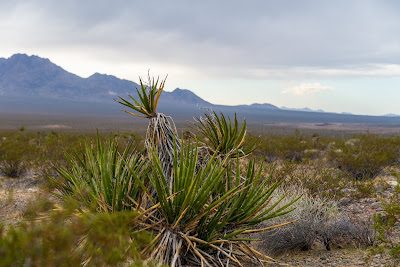Our clean energy path will not be cheap, but it should not involve subsidizing the same corporate greed that continues to wreck our wildlands. The Los Angeles Times published
an article detailing the costs to taxpayers and ratepayers for giant solar facilities responsible for destroying desert habitat, and the fact that companies investing in these projects receive an incredible return on their investment. Some of these companies responsible for remote desert solar facilities will probably be familiar to you -- JP Morgan Chase & Co., Morgan Stanley, General Electric, and Berkshire Hathaway. These are the same companies that also profit from fossil fuels.
It does not matter if the bulldozer is making way for a natural gas well or a wind turbine -- for these companies, the end is profit, and the means is anything that will increase that profit.
As we advocate for a clean energy future, we should ask ourselves if we're willing to take shortcuts that destroy the things we love -- unspoiled landscapes and biodiversity -- or take the responsible path of generating clean energy where we live or on already-disturbed lands. What is missing in the Los Angeles Times article is a discussion of these responsible options. Many people commenting on the article take a black and white approach, either you have desert-destroying solar or you have catastrophic climate change. But in the midst of a heated debate, very few people recognize what fossil fuels and large-scale desert solar and wind facilities have in common -- an insatiable appetite for land. An appetite for the landscapes and wildlife we cherish.
 |
| A bulldozer clears land in northwestern United States for a sing wind turbine. The wind energy production tax credit has kept the wind industry afloat, and attracted Wall Street investors. Wind projects have spread from the farmlands of the midwest, and are now beginning to industrialize public lands across the West. The wind industry is more intent on growing its profit than protecting ecosystems. |
No form of energy is cheap. Oil, natural gas, or solar in the desert. In each case we are absorbing costs that are not reflected in the per watt price -- asthma, lung cancer, clean water, the loss of rare plants or animals, or a landscape forever spoiled by fields of mirrors or wells. We are subsidizing an appetite for natural resources -- when we give Big Oil, Big Solar, or Big Wind the tax breaks that only increase their profit margins. Each of these business models depend on a common denominator -- people looking the other way as corporations destroy nature. Another common denominator is that each company acts as a wealth aggregator. A select few people benefiting enormously from the public investment in their business model.
 |
| [Click on image to expand] This photo shows the footprint of BrightSource Energy's Ivanpah Solar project, being built on 5.6 square miles of intact desert habitat in the northeastern Mojave Desert. California has already installed enough rooftop solar energy to avoid four Ivanpah Solar projects. |
It's time for this insanity to stop. It's time to give our wildlands a break. It's time that we advocate for an energy model that invests in our communities, and not in Wall Street. Study after study shows that our rooftops and cities are vast reservoirs for local solar energy, and energy efficiency savings. Critics complain that distributed generation -- solar panels on rooftops or over parking lots -- is expensive. But coal power plants that spew toxins in our communities actually ruin lives, and giant wind facilities that kill rare
birds and
bats for the sake of corporate profits are not "green." This is the same
greed we have been subjected to for too long.
We should redirect the tax breaks and subsidies away from Shell Oil and BrightSource Energy, and give our neighbors a chance to install rooftop solar, or improve their energy efficiency. We can save on energy bills, make our communities more sustainable, and save wildlands for future generations. Nobody said the right path would be easy or cheap, but it does not have to be greedy, either.
 |
| A school district in southern California installed solar panels over the parking lot, generating clean energy and savings on its utility bill. Best of all, no extra land had to be destroyed to support the school's energy needs. |





Comments
Post a Comment